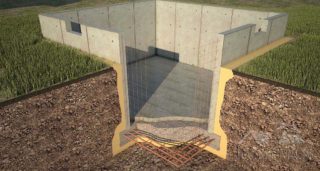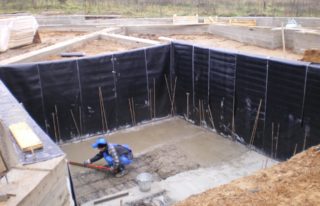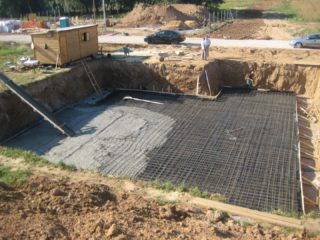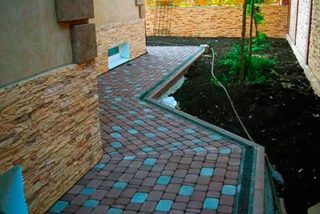The basement is an additional room that is not considered a floor by law. The structure, half submerged in the ground, is an excellent insulating layer that protects the house from cold and dampness. A foundation with a plinth can be used for arranging a cellar, workshop, garage and even a guest room with effective ventilation. A good solution is placement in the underground level of technology, which ensures the vital activity of the building - a heating boiler, a storage tank, an electrical panel, a generator, a gas distribution box.
Types of foundations for the basement

The construction of a high basement basement for a private house is much more expensive than the arrangement of a shallow tape, a monolithic slab, not to mention a pile foundation. Nevertheless, the costs incurred immediately begin to pay off with a healthy microclimate in the house, the practicality and functionality of the underground structure. In addition to convenience, the recessed support systems are characterized by high load-bearing capacity. Even a two-story brick mansion can be built on them without any fear.
Before erecting the basement level, it is necessary to determine the level of its deepening and its location relative to the floor slab of the first floor.
There are such types of foundations for a house with a basement floor:
- Recessed (sinking). In terms of its dimensions, the first level of the house is already 3-10 cm, which is very convenient in terms of waterproofing, since the penetration of water between the two structures is completely excluded. At the same time, the bearing capacity of the base remains unchanged.
- Speaker. Such foundations are distinguished by powerful and thick walls, larger than those of the structure on top. A complex of expensive measures is required to protect the joint from moisture.
- Smooth. The exterior walls of the house and the foundations are of the same level, which is not bad from an aesthetic point of view. But good waterproofing of the joint is needed.
In accordance with current regulations, the foundation with a basement floor must be buried in the ground at least half of its height.
Pit preparation

In most cases, such structures are immersed in the ground to a depth of at least 200 cm. This is due to factors such as the level of soil freezing and the occurrence of groundwater. Both conditions are important, since when heaving, the support system will not be pushed out, and the risk of its undermining will be reduced to zero. In many ways, the quality of the finished structure is determined by a competent approach to the arrangement of the pit.
This procedure should be carried out in the following sequence:
- Determine the construction site, navigate to the cardinal points. Apply the markings, check the conformity of the dimensions of the sides and diagonals between the corners.
- Clear the work area from vegetation, debris and small structures.
- Check if there are any communications underground at the construction site.
- Remove the top fertile soil layer, move it to the place for further application.
- Start digging a hole. Since this is a very large amount of work, it is better to spare the money and hire an excavator. Corners and minor imperfections can be manually tweaked.
- If the walls of the pit are crumbling, they should be immediately reinforced with steel mesh or wooden shields.
- Form a pillow.For this, sand and crushed stone are used. Depending on the type of soil, the total thickness of the backfill is 30-50 cm.
- Assemble the formwork. Planks, waterproof plywood and boards are used. Experts recommend using prefabricated sliding formwork. This is explained by the fact that if you immediately assemble a form with a height of 200-250 cm, you will not be able to correctly install the frame in it, problems will arise with pouring concrete. The first level should be done no higher than 100 cm.
- Cover the walls of the formwork with grease or cellophane to prevent dehydration of the mortar.
- Finally, a preliminary screed is made of lean concrete up to 5 cm thick on the pillow.
If construction is carried out on a slope, that part of the soil is selected that is necessary to create a flat area with a margin of at least 200 cm to the edge.
Choice of foundation design with basement and terrace

The foundation for a house with a plinth and a terrace is a rather complex structure. For its arrangement, it is required to choose the right material from which the walls of the support system will be erected.
There are the following options for the construction of the basement level:
- Block tape. It is assembled from powerful reinforced concrete blocks of 240 × 60 × 40 cm format. Fragments can be joined together by welding; in all cases, cement mortar is used. The advantage of this method is the high speed of construction, but delivery and installation will have to be spent.
- Monolithic. It is considered the most time consuming, but at the same time the most reliable type of basement floor. Thanks to the one-piece structure, leaks, shears and crevices are virtually eliminated. The structure is a closed form with an internal steel frame, poured with concrete.
- Brick. Refers to budget options, since the only serious expenses go to the delivery of material and a fragment of the pit. Next comes manual work, where there is no need to make formwork and reinforcement. The downside is that brickwork is not resistant to high loads and dampness. You can choose this technology when building on dry and stable ground.
The strip foundation is strong, but it needs additional protection from external and internal factors.
Blind area device

The blind area is a slab built around the perimeter of the house with breaks on the porch.
This design performs the following functions:
- protection of walls from dirt and water;
- blocking the penetration of moisture and cold to the underground part of the foundation;
- creation of a footpath along the building;
- giving the house a finished look;
- prevention of erosion of the ground by rain streams flowing from the roof.
The blind area is made of concrete, asphalt, paving slabs and crushed stone. The width of the strip should be 20 cm more than the roof overhang, but not already 100 cm. Thermal insulation is done with tiled, loose and sprayed material
Waterproofing is designed to protect concrete from destruction and moisture penetration into the underground room. The procedure is carried out by pasting and coating methods. In the first case, roll materials are used, applied to all vertical surfaces. The second method involves the use of various polymer and bitumen mixtures, which are applied to concrete in liquid form after melting.
Expert advice
Experts recommend the following:
- make a basement level with a margin of safety with the prospect of completing the house;
- lay the foundation as deep as possible, otherwise one particularly cold winter can destroy it;
- it is imperative to make thermal insulation, since most of the structure is located in the horizon of soil freezing;
- take out the basement at least 100 cm above the ground, so that it is possible to equip windows.
These simple guidelines will help you avoid annoying mistakes that will be difficult or impossible to fix.








